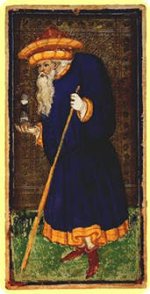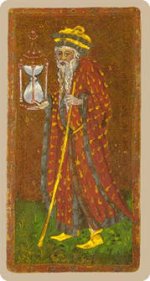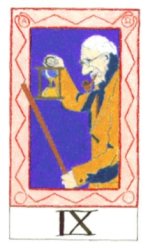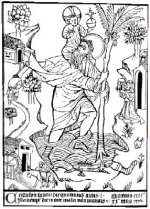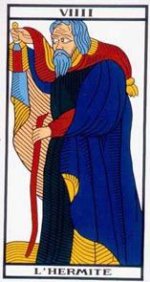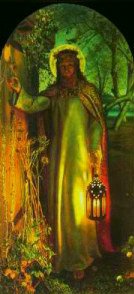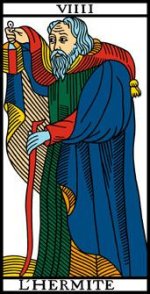catboxer
I have a lot of problems with this card, because one of its main pictorial elements was changed not long after the first appearance of tarot, and the meaning of the card was irrevocably altered. Originally, the old man held an hourglass, not a lantern, and the card was called "The Old Man," or "The Hunchback" (for the figure in the Visconti-Sforza version clearly suffers this disfigurement), or even "Time." I was gratified to see that when Luigi Scapini executed the replacement card for this trump in the Cary-Yale deck, he shows the old man carrying an hourglass.
This means that originally the card was a representation of our acute and constant awareness of our own mortality, of the inevitable and relentless passage of time, and its attendant onset of old age and dissolution. There is also a clear association of the trump's figure with the Greek god Cronos, who has persisted in our culture as "Father Time;" we still see him in cartoons, carrying his scythe and hourglass, at the turn of every new year. This interpretation is confirmed by a 16th-century Ferrarese card now in the Bibliotheque Municipale in Rouen, which shows Saturn carrying his scythe and standing with one foot on an hourglass (M. Dummett, "The Visconti-Sforza Tarot Cards," p. 122).
The initial alteration of this card might have occurred with the appearance of inexpensive woodblock-printed packs, as the earliest ones, from the late 15th or early 16th century (numerous uncut sheets are in both the Metropolitan Museum in New York and the Museum of Fine Arts in Budapest) show the old man with what is probably a lantern. Perhaps the hourglass was simply too difficult an element for the woodblock artists to execute in this relatively crude format. At any rate, this substitution changes the card's meaning, since the old man carrying a light is now a seeker after truth, looking to find his way on an unclear path, rather than a representation of the Greek god of time. By the time of the appearance of the Marseilles decks, the change had become firmly established, and the Old Man was now forever to be the Hermit.
Personally, I find this change unfortunate. One of the most commonly manifested and uniquely human attributes is our awareness of our eventual fate. Scarcely a day goes by that every person doesn't think of it, and it's one of a limited number of everyday feelings that life is made of. In attempting to understand tarot, I try to avoid arcane, abstracted, highly theoretical interpretations, and have a decided preference for concrete, specific, and tangible meanings. It seems to me that a symbolic set of pictures that addresses the human condition would not leave out the most common human experiences: romantic love, awareness of mortality, and so forth.
(catboxer)
This means that originally the card was a representation of our acute and constant awareness of our own mortality, of the inevitable and relentless passage of time, and its attendant onset of old age and dissolution. There is also a clear association of the trump's figure with the Greek god Cronos, who has persisted in our culture as "Father Time;" we still see him in cartoons, carrying his scythe and hourglass, at the turn of every new year. This interpretation is confirmed by a 16th-century Ferrarese card now in the Bibliotheque Municipale in Rouen, which shows Saturn carrying his scythe and standing with one foot on an hourglass (M. Dummett, "The Visconti-Sforza Tarot Cards," p. 122).
The initial alteration of this card might have occurred with the appearance of inexpensive woodblock-printed packs, as the earliest ones, from the late 15th or early 16th century (numerous uncut sheets are in both the Metropolitan Museum in New York and the Museum of Fine Arts in Budapest) show the old man with what is probably a lantern. Perhaps the hourglass was simply too difficult an element for the woodblock artists to execute in this relatively crude format. At any rate, this substitution changes the card's meaning, since the old man carrying a light is now a seeker after truth, looking to find his way on an unclear path, rather than a representation of the Greek god of time. By the time of the appearance of the Marseilles decks, the change had become firmly established, and the Old Man was now forever to be the Hermit.
Personally, I find this change unfortunate. One of the most commonly manifested and uniquely human attributes is our awareness of our eventual fate. Scarcely a day goes by that every person doesn't think of it, and it's one of a limited number of everyday feelings that life is made of. In attempting to understand tarot, I try to avoid arcane, abstracted, highly theoretical interpretations, and have a decided preference for concrete, specific, and tangible meanings. It seems to me that a symbolic set of pictures that addresses the human condition would not leave out the most common human experiences: romantic love, awareness of mortality, and so forth.
(catboxer)

